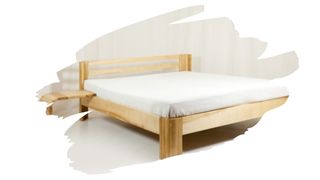Natural solid wood is one of the most durable materials you can make a bed from. But, many popular furniture hardwoods aren’t exactly that rot resistant.
For example, Hard Maple may be tough, but it’ll fast succumb to rot and decay if left untreated and unsealed.
So, one of the ways we protect wood from decay is to saturate it with wood preserving chemicals. This is called ‘pressure treatment’, and it is standard practice to treat any exterior wood.
But, what about interior wooden furniture? Is it safe to use these chemically treated timbers for a bed frame?
Well, in this post, you will find out what really goes into pressure treated wood. You will also discover which types of pressure treated wood are safest — and whether or not they are safe enough to be used for a bed frame.
And keep reading to find out what wood finish you should use to seal a wooden bed frame.

This post may contain affiliate links to products that we receive a commission for (at no additional cost to you). Learn more here.
What Does Pressure Treatment Do To Timber?
Pressure treated wood will have been put through a process that saturates it with (often) water-soluble chemicals preservatives.
Those preservatives prevent the bacteria responsible for wood rot, from making a home inside treated wood.
But, without a wood preservative treatment, untreated wood is much more susceptible to wood rot and decay. Especially if it is used on outdoor structures.
Is Pressure Treated Wood Safe To Use Indoors?
Most types of pressure treated wood, (especially older treated wood), will have been treated with very toxic chemicals. Some treatments even involve infusing wood with chemicals that can contain arsenic!
Now, those particularly toxic wood treatments have been banned from being used on timber meant for residential properties.
However, if you happen across some old/recycled treated wood, you can’t take the risk of bringing into indoors.
How Toxic Is Pressure Treated Wood?
It depends on the specific chemicals used.
Chromated copper arsenate (CCA) treated wood is too dangerous for us to be around. This particular treated wood is banned from being used around our homes because of its arsenic content.
However, green-treated Alkaline Copper Quaternary (ACQ) treated wood is fairly safe. It contains copper oxide, (which can be found in small amounts in some multivitamins).
Green treated wood — so called because copper turns this wood green — is safe to use around farms and gardens.
And Is Green Treated Wood Safe Enough To Make A Bed Frame?
Well, the amount of copper saturating this wood is low enough not to pose a toxicity risk to us. And if some of that ACQ preservative were to leach into garden soil, it would not poison your plants and vegetables.
Related Post: Should You Use Cinder Blocks (Vs Wood) For Your Raised Bed?
But, (and this is a pretty big but), this treated timber is not meant for interior furniture. And you should be leery about using it to make a bed you’ll be spending hours sleeping on every night.
So, you should also avoid using green treated wood for your bed frame as well.
So, What Kind Of Wood Is Suitable For A Bed?
You need to use a wood that is tough, durable, and also fairly naturally rot-resistant too.
The natural rot-resistance is more of an optional extra, but it will be of great advantage if you happen to live in a fairly humid climate.
Now, Hard Maple, Mahogany and Walnut wood are all great and popular choices.
But, if you want tough woods that also have superb rot-resistant characteristics, then White Oak, Teakwood and Rosewood are even better. Having said that, Teakwood and Rosewood are two pretty pricey tropical hardwoods.
Nevertheless, no matter which untreated wood you use to make your bed with, it’ll likely need a top coating sealant.
And What Is The Best Sealer For And Untreated Wooden Bed Frame?
Well, the best finish for that bed frame obviously needs to be water resistant.
It also needs to be durable enough to not require regular reapplications. So, you can cross Boiled Linseed oil and Tung oil off the list of possibilities.
Instead, the best finish you can use would be a clear polyurethane sealer.
Related Post: Are There Dust Nibs In Your Polyurethane Finish? (How To Fix It)
Wait…Will Polyurethane Make My Wooden Bed Frame More Durable?
Very much so, especially as polyurethane is flexible enough to shrug off scratches and dents. Plus, the urethane ingredient inside polyurethane is also great at waterproofing.
And unlike many other wood finishes, which tend to be microporous, it doesn’t allow humidity or moisture past it.
What Do You Mean By a Microporous Finish? A microporous wood finish is one that can prevent water droplets from soaking past. However, it does not stop water vapor from soaking into wood. So, a microporous wood finish is (at best) water-resistant, but never fully waterproof.
Will Polyurethane Prevent Rot From Getting Into My Bed Frame?
Absolutely it can, since this is one of a few finishes that can provide a truly long-lasting waterproofing coat.
Most other wood finishes can become water-damaged, such as Shellac or Lacquer. Or, they often need frequent reapplications throughout the year (i.e. Boiled Linseed oil or Tung oil).
Related Post: Boiled Linseed Oil vs Thompson’s Water Seal: Which One Is Better For Wood?
And What Kind Of Polyurethane Do You Recommend For My Bed Frame?
You should use an oil-based polyurethane product to seal over timber. An oil-based poly will enhance the appearance of the grain of wood. And, it allows wood to look its most natural after it’s been applied.
Which is why you should get Minwax’s Fast-Drying Clear Finish. Minwax’s clear oil-based polyurethane product can be coated onto all manner of interior wood items, from furniture to decorations.
And it takes fewer than four hours to dry. So, you can apply multiple coats of this polyurethane within a single day.
Quick Tip! Apply Oil-Based Polyurethane Using A Bristle Brush: Don’t use a foam brush to coat on oil-based polyurethane. A foam brush can leave behind a surface coat that’s filled with tiny air bubbles.
To Wrap Up, Here Are The 3 Key Takeaways From This Post…
- 1). Pressure treated wood has been treated with chemical wood preservatives designed to help timber fight off wood rot.
- 2). Pressure treated wood is meant to be used outdoors. It is not suitable for interior furniture.
- 3). Instead, use untreated wood to make your bed frame. And then seal it with a top coating oil-based polyurethane sealer.
References:
Treated Wood In The Landscape | Home & Garden Information Center



